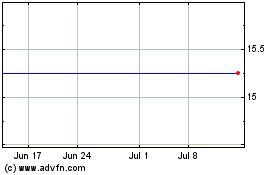UPDATE: New Jersey Passes Law To Build New Gas-Fired Power Plants
January 31 2011 - 8:03PM
Dow Jones News
New Jersey Governor Chris Christie signed into law Friday a
program of long-term incentives to build new power plants in the
state, against opposition from within the U.S.'s largest
electricity market.
The program would provide up to a decade of incentive payments
to developers for the construction of 2,000 megawatts of natural
gas-fired generation, enough to provide electricity for about two
million homes. The move guarantees a minimum return to developers
to build plants.
New Jersey is part of the 13-state competitive electricity
market operated by PJM Interconnection LLC, where companies have
used market price signals to determine whether to build a new plant
or pursue other investments.
Lawmakers say the program will reduce some of the highest power
prices in the country, curb greenhouse gas emissions and create
jobs.
The current pricing model benefits existing electricity
suppliers and "it actually serves to discourage the development of
new power generation to replace the old, inefficient and polluting
power plants with new, more efficient and cleaner plants," said
spokesman Michael Drewniak for Gov. Christie in an email.
Initial projects expected to benefit from the new law include a
640-megawatt plant by LS Power Development LLC in West Deptford,
the town where proponent New Jersey Senate President Stephen lives,
and a roughly 700-megawatt plant by Competitive Power Ventures LLC
in Woodbridge.
But major power producers in the state oppose the legislation
and are expected to seek legal action against the bill.
"We believe that it will ultimately lead to higher energy bills
for New Jersey consumers, fewer jobs and make it unlikely future
power plants will be built in the state without government
subsidies," Public Service Enterprise Group Inc. (PEG) spokesman
Michael Jennings said in an email. PSEG, the state's largest
utility company, has said the program will cost consumers more than
$1 billion.
The P3 Power Providers Group is preparing to file a complaint to
the Federal Energy Regulatory Commission, which has jurisdiction
over the regional electricity markets, to prevent subsidized power
plants from undermining market prices, said Glen Thomas, president
of the industry advocacy group. Its members include PSEG; Exelon
Corp. (EXC); Constellation Energy Group Inc. (CEG); NextEra Energy
Inc. (NEE); NRG Energy Inc. (NRG); Calpine Corp. (CPN); PPL Corp.
(PPL); and GenOn Energy Inc. (GEN)
PJM's independent market monitor has also opposed the
program.
The program concerns what are known as capacity payments made
regularly to power companies as a reward for keeping plants ready
to meet peak demand load three years from now, not for power
produced. The payments are set through annual PJM auctions and the
capacity payments are funded by consumers through electricity
rates. Power plant owners rely on this cash flow to cover costs and
make investment decisions.
The new state law will allow developers to lock in capacity
payments outside of this auction system for up to 10 years, instead
of the three-year limit set up by PJM.
The new generation built under the New Jersey law will have to
bid into the PJM auction in May 2011 or 2012 and to win it
developers are expected to place artificially low bids because
their payments will be guaranteed through a separate charge on
utility customers' bills.
New Jersey has some of highest capacity payments in the country.
Last May, it was set at $245 a megawatt a day, compared to less
than $30 a megawatt a day in western parts of the PJM market, where
population centers are less congested. The new generation could cut
$2 billion in annual PJM capacity payments, Drewniak said.
PJM spokesman Terry Williamson said that these cost-savings are
not guaranteed and that next month a task force will discuss
revising rules to subsidized developers from placing zero-dollar
bids. PJM is also considering whether to offer longer term
contracts to support building new generation.
While capacity prices are headed higher, Exelon Chief Executive
John Rowe said in a call with analysts last week that the outlook
"remains murky" given New Jersey's program and PJM's reduced
forecast for power demand growth over the next decade.
Despite staunch opposition, state legislators passed the bill
with little opposition with the hope of stirring local
economies.
Competitive Power could not be reached for comment.
-Naureen S. Malik, Dow Jones Newswires; 212-416-4210;
naureen.malik@dowjones.com
Calpine (NYSE:CPN)
Historical Stock Chart
From May 2024 to Jun 2024

Calpine (NYSE:CPN)
Historical Stock Chart
From Jun 2023 to Jun 2024
